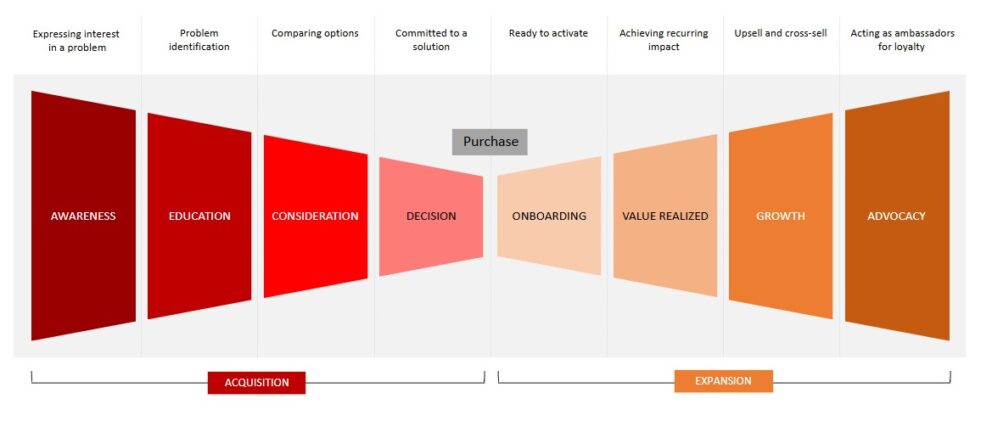Missing the Forest for the Trees: Leading vs. Lagging Metrics

By Tom Swanson, Engagement Manager at Heinz Marketing
Too long, didn’t read: Goodhart’s Law should be used for leading metrics, but lagging metrics make great targets. In fact, the further downline you go, the better they get (to a point).
Today we are going to be talking about a topic I have been exploring for a while: Goodhart’s “Law”. For those of you who are unfamiliar, the adage goes “when a measure becomes a target, it ceases to be a good measure.”
One could make the argument that good test scores would suggest an effective teacher. That is the basis behind using test scores to evaluate teachers, and predictably, teachers changed their techniques to what would drive high test scores. The results have been wild.
The sudden influx of numerousness in education led to people gaming the system, whatever could be done to get test scores up. Often times, children were categorized by proximity to a passing grade, with most of the effort being to the students on the verge of passing, test after test. That means less resources for the students who are behind and need it most. Even advanced students suffered deleterious effects, being slowed in their development by a lack of attentive coaching.
Not only does this throw off the allocation of precious time, it also necessitates the changing of methods to those that are most likely to generate better test scores. In some cases, that is fine, tests are an important part of gauging learning. However, when the learning becomes all about the test, the result is non-durable learning that is less likely to improve long-term student outcomes.
The overall quality of education for everyone falls in this situation.
Tests are important, but they are only a step along the road to a good outcome for each student. Similarly, many of our own metrics as marketers are just steps along a buyers journey towards some form of decision. The moment we start to set goals around them that people are evaluated on, we skew the choices teams will make towards those metrics.
Does Goodhart’s Law apply to all marketing metrics?
With the example above in mind, it might seem that we should reconsider how we assess metrics. What we really want to know is how we can set goals without prompting teams to miss the forest for the trees, so to speak.
We break metrics into two categories: leading and lagging, but it is really more of a spectrum of how much time has elapsed since you took an action. The concept is pretty straightforward, but if you are unfamiliar, it looks something like this:
Here is the deal: in almost every situation, we will state that the metrics closest to our outcome are the ones we should care most about. They are things like:
- Revenue
- Qualified pipeline
- 2nd meeting show-up rate
- Pipeline velocity (really a compound of a bunch of lagging metrics)
Most marketers are focused on the leading end of the spectrum. They build content, run campaigns, develop nurtures, and so much more to generate demand. The most immediate metrics tend to be what they focus on.
The problem with this is that those metrics don’t necessarily imply success in the long term. Focusing on just leads generated, or even MQLs qualified, leads to targeting volume rather than quality. Targeting just the leading metrics misses the rest of the spectrum. That might work for some businesses, but for many (especially those making a play at enterprise firms) quality is the better target.
The fact is that targeting leading metrics emphasizes the efficacy of the action itself rather than its role in moving the number that matters: revenue. The further your metric is to the left side of the spectrum, the less likely it is to be effective as a target unto itself.
Loving the Lag
Per the title of the post, I love lagging metrics. If you can get comfortable with waiting on your numbers, you will see a much wider picture. It isn’t just about how many MQLs you generate, it is about how those exact ones move to pipeline, get qualified, move through sales, and ultimately convert to revenue. If you are patient, and you executives can understand, your ability to make decisions that drive revenue will jump drastically.
All of the sudden, you are looking not just at isolated performance, but at a whole ecosystem of demand generation. The components all influence each other, but you miss this critical component if you are looking at performance by individual tactics.
This isn’t to say that you should only target revenue, obviously. Just like in the teaching analogy, tests aren’t inherently bad, but a system that prioritizes test scores over long-term outcomes is. Seeing your leading metrics, and how they contribute to our main priority, is key to an effective strategy that orchestrates all of the components together.
Decisions should be made based on how all of the pieces fit together, rather than the individual outcomes of a specific part. Like a great forest, this is about knowing the role that each piece plays in the great demand gen food chain. Over-feed or over-prune any one piece based on its individual impact and you may hinder the system as a whole.
This is possible through setting targets around lagging metrics and studying how leading metrics all fit in. Map your ecosystem, and learn to love the lag.

Metrics indicate an ecosystem, and you can’t measure tree growth right after planting. You gotta wait!
Alignment
Goodhart’s Law applies to marketing, there is no doubt about it. Targeting leading metrics is a great way to miss the point of most demand generation. It prioritizes short-term gain, mis-aligns you with sales, product, and the other teams in your company.
In order to overcome Goodhart’s law, you need to focus on the metrics that matter, then build backward from there. Everyone in the company is there to grow it, and marketing does that through generating revenue. From there you can seek out the right ecosystem of actions and measures to see what really works for you.
The biggest knock-on effect of this is alignment. With marketing, sales, and product working towards the same metric, it is so much easier to harmonize and build a revenue funnel that is scalable and reliable. Each team knows the others are focusing on the same metrics, and everything is easier from there.
If you are considering where to measure and how to report, we highly recommend focusing on the lagging metrics and building backwards. Don’t miss the forest for the trees.







